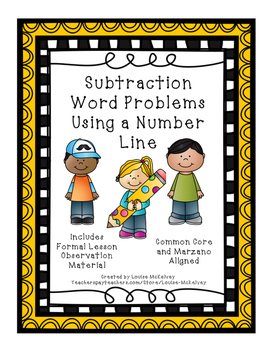Formal Lesson Observation Subtraction with a number line
Adventures in Primary
228 Followers
Grade Levels
K - 2nd
Subjects
Resource Type
Standards
CCSS1.OA.A.1
CCSS1.OA.C.6
Formats Included
- PDF
Pages
33 pages
Adventures in Primary
228 Followers
Description
Are you teaching addition and subtraction strategies? Do you want a fun, hands-on activity for your students?
Are you trying to think of a great lesson for your students that you can also use for your FORMAL OBSERVATION??!!
**Marzano and Common core aligned**
Then look no further!
This 33 page packet includes everything you need to prepare for a successful, hands-on math lesson that can also be used for a formal observation; from rubrics to learning goals, guided practice to differentiated work. Color and black and white copies are included for display and multiple student copy distribution.
An enormous time saver with cute activities and full description on how to present the lesson, incorporating Marzano high yield strategies.
I used this with my 1st grade students but this could be easily adapted for kindergarten/2nd grade students.
This lesson was a big success for me, I'm sure it will be for you, too!
Here's what's included...
*Lesson Overview/directions
*Lesson Plan/Framework
(including suggestions for Marzano Pre-conference form A)
*Learning Goal poster
*Common Core standards poster
*BME Chart for the entire Unit of Work on addition and subtraction strategies
*Lesson Rubric - in color (I enlarged this to poster size and display in the classroom
*Lesson Rubric (black and white for student distribution)
*Labels for Student Workbooks
*Number lines for students to use on carpet
*Butterfly Teacher practice paper (“I Do”) in color for teacher modeleing/whole group practice. (I enlarged to poster size)
*Ladybug Teacher/Group practice paper (“We Do”) in color for whole group practice (I enlarged to poster size)
*Bee, Dragonfly, Ladybug and Ant differentiated, independent practice for student workbooks (using 0-10 and 10-20 number lines for differentiation)
*Photograph examples from the classroom
*Thank You page
I hope you will find this useful in your classroom..
If you have any questions/concerns, please feel free to
contact me. My email address is: Lolliw@gmail.com
I would like to acknowledge the following:
Fonts for Peas
The Learning Tree Fonts
Krista Wallden http://www.teacherspayteachers.com/Store/Krista-Wallden
Whimsy Clips http://www.teacherspayteachers.com/Store/Whimsy-Clips
Graphics by Emily Education:
http://www.teacherspayteachers.com/Store/Emily-Education
www.emilyeducation.blogspot.com
http://www.teacherspayteachers.com/Store/A-Teachers-Idea
Michael Rawls
http://www.teacherspayteachers.com/Store/Monster-Wrangler-Mike
Please don’t forget to follow me and rate me so you can earn
credits to use on future purchases at TPT.
Thanks again,
Louise McKelvey
Are you trying to think of a great lesson for your students that you can also use for your FORMAL OBSERVATION??!!
**Marzano and Common core aligned**
Then look no further!
This 33 page packet includes everything you need to prepare for a successful, hands-on math lesson that can also be used for a formal observation; from rubrics to learning goals, guided practice to differentiated work. Color and black and white copies are included for display and multiple student copy distribution.
An enormous time saver with cute activities and full description on how to present the lesson, incorporating Marzano high yield strategies.
I used this with my 1st grade students but this could be easily adapted for kindergarten/2nd grade students.
This lesson was a big success for me, I'm sure it will be for you, too!
Here's what's included...
*Lesson Overview/directions
*Lesson Plan/Framework
(including suggestions for Marzano Pre-conference form A)
*Learning Goal poster
*Common Core standards poster
*BME Chart for the entire Unit of Work on addition and subtraction strategies
*Lesson Rubric - in color (I enlarged this to poster size and display in the classroom
*Lesson Rubric (black and white for student distribution)
*Labels for Student Workbooks
*Number lines for students to use on carpet
*Butterfly Teacher practice paper (“I Do”) in color for teacher modeleing/whole group practice. (I enlarged to poster size)
*Ladybug Teacher/Group practice paper (“We Do”) in color for whole group practice (I enlarged to poster size)
*Bee, Dragonfly, Ladybug and Ant differentiated, independent practice for student workbooks (using 0-10 and 10-20 number lines for differentiation)
*Photograph examples from the classroom
*Thank You page
I hope you will find this useful in your classroom..
If you have any questions/concerns, please feel free to
contact me. My email address is: Lolliw@gmail.com
I would like to acknowledge the following:
Fonts for Peas
The Learning Tree Fonts
Krista Wallden http://www.teacherspayteachers.com/Store/Krista-Wallden
Whimsy Clips http://www.teacherspayteachers.com/Store/Whimsy-Clips
Graphics by Emily Education:
http://www.teacherspayteachers.com/Store/Emily-Education
www.emilyeducation.blogspot.com
http://www.teacherspayteachers.com/Store/A-Teachers-Idea
Michael Rawls
http://www.teacherspayteachers.com/Store/Monster-Wrangler-Mike
Please don’t forget to follow me and rate me so you can earn
credits to use on future purchases at TPT.
Thanks again,
Louise McKelvey
Total Pages
33 pages
Answer Key
N/A
Teaching Duration
N/A
Last updated Mar 8th, 2014
Report this resource to TPT
Reported resources will be reviewed by our team. Report this resource to let us know if this resource violates TPT’s content guidelines.
Standards
to see state-specific standards (only available in the US).
CCSS1.OA.A.1
Use addition and subtraction within 20 to solve word problems involving situations of adding to, taking from, putting together, taking apart, and comparing, with unknowns in all positions, e.g., by using objects, drawings, and equations with a symbol for the unknown number to represent the problem.
CCSS1.OA.C.6
Add and subtract within 20, demonstrating fluency for addition and subtraction within 10. Use strategies such as counting on; making ten (e.g., 8 + 6 = 8 + 2 + 4 = 10 + 4 = 14); decomposing a number leading to a ten (e.g., 13 - 4 = 13 - 3 - 1 = 10 - 1 = 9); using the relationship between addition and subtraction (e.g., knowing that 8 + 4 = 12, one knows 12 - 8 = 4); and creating equivalent but easier or known sums (e.g., adding 6 + 7 by creating the known equivalent 6 + 6 + 1 = 12 + 1 = 13).





